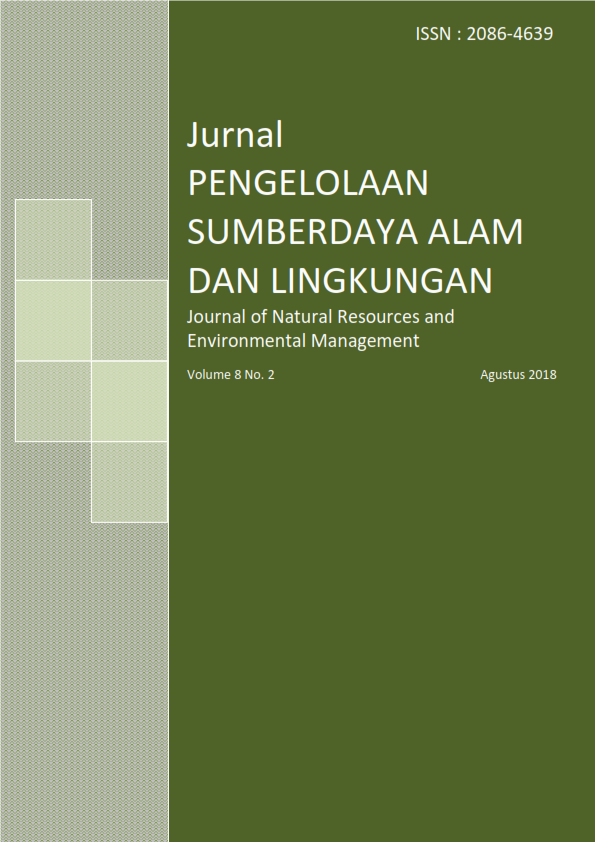ANALISIS PERUBAHAN TUTUPAN LAHAN DAS TONDANO, SULAWESI UTARA SELAMA PERIODE TAHUN 2002 DAN 2015
Abstract
References
Castilla, G., G. J. Hay, G, 2007. Uncertainties in land use data. Hydrology and Earth System Sciences. 11, pp. 1857–1868.
Duro, D.C., S. E. Franklin, dan M. G. Dubé, 2012. A comparison of pixel-based and object-based image analysis with selected machine learning algorithms for the classification of agricultural landscapes using SPOT-5 HRG imagery. Remote Sensing of Environment. 118, pp. 259-272.
El-Hattab, M.M., 2016. Applying post classification change detection technique to monitor an Egyptian coastal zone (Abu Qir Bay). The Egyptian Journal of Remote Sensing and Space Sciences. 19, pp. 23-36.
FAO, 2007a. Forest monitoring and assessment for climate change reporting: partnership, capacity building and delivery. Forest Resources Assessment. Working Papers. 142. Rome.
FAO, 2007b. Global Forest Resources Assessment 2010. Working Papers 141. Rome.
Hakan, A. et al., 2009. Post-classification comparison of land cover using multitemporal Landsat and ASTER imagery: the case of Kahramanmaraş, Turkey. Environ Monit Assess. 151, pp. 327–336.
Hegazya, I., M. Kaloop, 2015. Monitoring urban growth and land use change detection with GIS and remote sensing techniques in Daqahlia governorate Egypt. International Journal of Sustainable Built Environment. 4(1), pp. 117–124.
Jensen, J. R., 2007. Remote Sensing of the Environment. Second Edition Pearson Prentice Hall.
Lillesand, T. M., Kiefer, R. W., 2015. Remote sensing and image interpretation. 7th Edition. John Wiley & Sons, Inc, New York.
Lu, D. et al., 2004. Change detection techniques. International Journal of Remote Sensing. 25(12), pp. 2365 – 2407.
Peiman, R. 2011. Pre-classification and post-classification change-detection techniques to monitor land-cover and land-use change using multi-temporal Landsat imagery: a case study on Pisa Province in Italy. International Journal of Remote Sensing 32(15), pp 4365-4381.
Prenzel, B, P. Treitz , dan E. LeDrew, 2006. Remote sensing for environmental monitoring and management: A case study of Tondano Waterhsed. Dalam T. Babcock, S. Wismer and B. Nurkin (Editors). From sky to sea. Environment and Development in Sulawesi. Department of Geography, University of Waterloo, Waterloo, Canada.
Rotinsulu, W., H. Walangitan, 2015. Analisis Perubahan Tutupan Lahan DAS Tondano dan DAS Likupang Di Sulawesi Utara Dengan Metode Penginderaan Jauh dan Sistem Informasi Geografis. Laporan Hasil Penelitian RUU Unsrat Tahun 2015.
Shalaby, A., R. Tateishi, 2007. Remote sensing and GIS for mapping and monitoring land cover and land use changes in the Northwestern coastal zone of Egypt. Applied Geography. 27(1), pp. 28–41.
Whiteside, T., W. Ahmad, 2005. A comparison of object-oriented and pixel-based classification methods for mapping land cover in Northern Australia. Proceedings of SSC2005 Spatial intelligence, innovation and praxis: The national biennial Conference of the Spatial Sciences Institute, September 2005. Melbourne: Spatial Sciences Institute.
Wijaya, N., 2015. Geoplanning: Journal of Geomatics and Planning. 2(2), pp. 82-92.
Authors
Authors who publish with this journal agree to the following terms:
- Authors retain copyright and grant the journal right of first publication with the work simultaneously licensed under a Creative Commons Attribution License that allows others to share the work with an acknowledgement of the work's authorship and initial publication in this journal.
- Authors are able to enter into separate, additional contractual arrangements for the non-exclusive distribution of the journal's published version of the work (e.g., post it to an institutional repository or publish it in a book), with an acknowledgement of its initial publication in this journal.
- Authors are permitted and encouraged to post their work online (e.g., in institutional repositories or on their website) prior to and during the submission process, as it can lead to productive exchanges, as well as earlier and greater citation of published work (See The Effect of Open Access).






